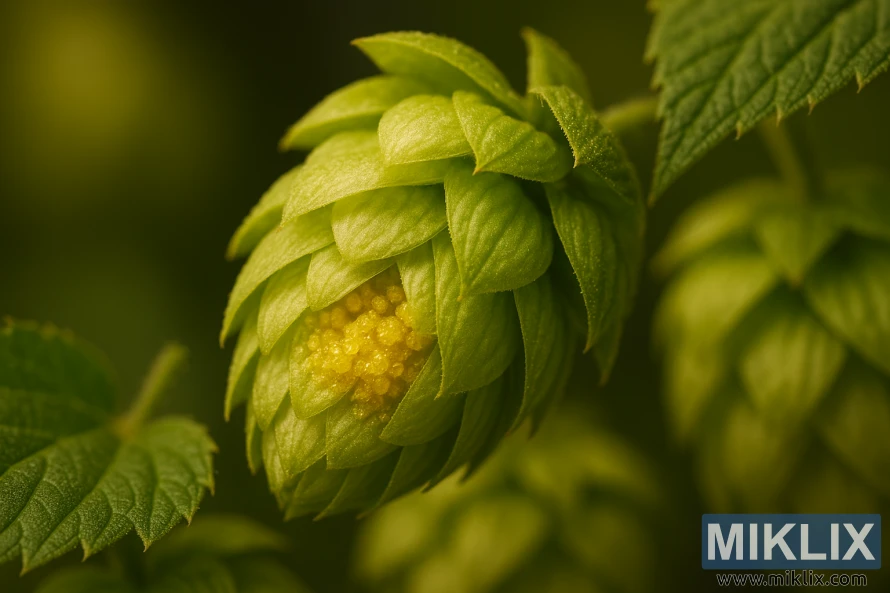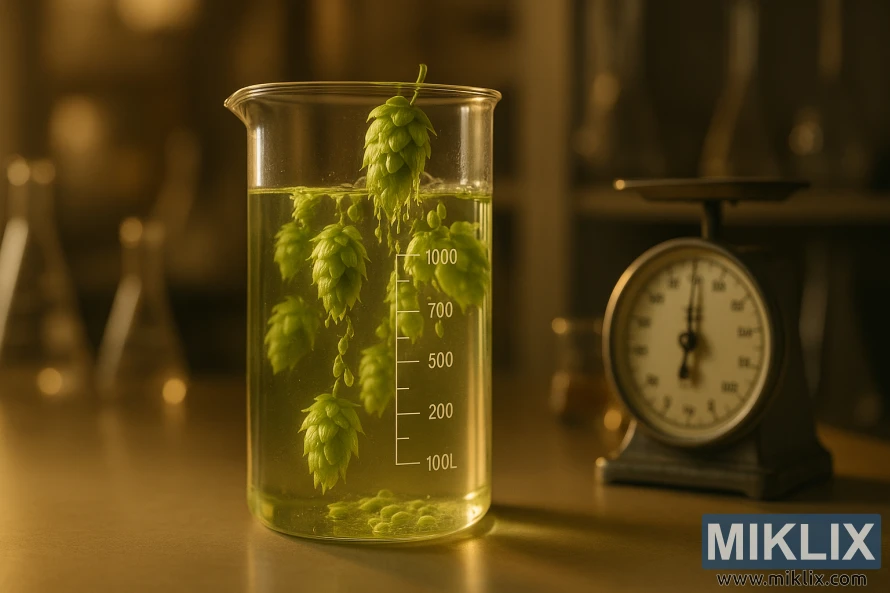Hops in Beer Brewing: Cashmere
Published: October 25, 2025 at 4:18:32 PM UTC
Cashmere hops emerged from Washington State University in 2013, quickly becoming a staple in West Coast brewing. This variety combines Cascade and Northern Brewer genetics, offering a soft bitterness and a bold, fruit-forward aroma. Homebrewers and craft breweries appreciate Cashmere hops for their tropical melon, pineapple, peach, coconut, and lemon-lime flavors. With alpha acids ranging from 7–10%, Cashmere is versatile, suitable for both bittering and late additions in brewing.

This Cashmere brewing guide will assist you in selecting the right usage and beer styles. It will also provide insights into flavor and bitterness when brewing with Cashmere hops.
Key Takeaways
- Cashmere is a Washington State University release with Cascade and Northern Brewer heritage.
- The hop shows 7–10% alpha acids and works well as a dual-purpose hop.
- Flavor notes include tropical fruits, citrus, and lemongrass.
- Cashmere hops USA are widely available in kits and single-hop recipes for homebrewers.
- Secure payment methods and clear shipping policies make online purchases straightforward.
Overview of Cashmere hops in Modern Brewing
Cashmere hops stand out as a versatile choice in modern craft brewing. They are prized for their ability to add bright fruit notes and provide strong bittering. This balance makes them ideal for hazy IPAs, pale ales, saisons, and sours.
The origins of Cashmere hops can be traced back to West Coast breeding programs. Washington State University introduced Cashmere, combining Cascade and Northern Brewer traits. This blend results in citrus and stone fruit aromas with a firm bitterness.
The 2013 release of Cashmere hops marked a significant moment for university-bred varieties in craft brewing. It increased availability for both commercial brewers and homebrewers. Today, you can find Cashmere hops in recipe kits and packaged forms, catering to both new and experienced brewers.
- Flavor role: bright, tropical, and lemony top notes.
- Brewing role: works as both late-addition aroma hop and early bittering hop.
- Market role: widely stocked for homebrew kits and commercial use.
This brief overview showcases why Cashmere has become a staple in modern brewing. It offers fruit-driven complexity with reliable bitterness, making it a go-to choice for brewers.
Flavor and Aroma Profile of Cashmere
Cashmere hop flavor is a blend of tropical and fruit-forward hops, ideal for brewers seeking a bright, sunny character. It offers notes of melon, peach, and a sweet pineapple quality. Some batches also feature a softer coconut note.
The aroma of Cashmere is citrusy, with lime peel and lemon-lime soda highlights. Herbal and lemongrass accents add complexity, creating a layered scent profile. This stands out more than classic Cascade.
In hoppy styles, coconut pineapple hops are prominent with late additions or dry hops. This makes Cashmere perfect for hazy IPAs and pale ales. Here, hop oils dominate the glass, allowing fruit-forward hops to shine.
Used in saisons or sours, Cashmere transforms the base beer with a bright, tropical presence. Brewers find that light-malted beers reveal the full range of Cashmere hop flavor. This makes aromatic notes more pronounced.
- Primary aromas: citrus, lime peel, lemon-lime soda
- Fruit notes: pineapple, melon, peach
- Supporting tones: coconut, lemongrass, herbal
Product kits and commercial examples often showcase Cashmere aroma in distinctive blonde ales and IPAs. The result is a beer that is fruity and fragrant without overwhelming the malt structure.
Alpha Acid and Bittering Characteristics
Cashmere alpha acids fall within the 7-10% range, positioning it as a moderate bittering option. Brewers often choose bittering hops Cashmere for its reliable IBUs without harshness. This makes it a versatile choice for various beer styles.
The hop's lineage from Northern Brewer enhances its ability to contribute elevated bitterness early in the boil. Simultaneously, Cashmere alpha acids provide a smooth bitterness. This characteristic complements malt backbone and hop-forward beers well.
Cashmere is a dual-purpose hop. Early additions offer clean bittering, while later additions, such as kettle and dry-hop, unlock its oil content. This reveals its aromatic and flavorful potential.
- Alpha range: 7-10% alpha acid — moderate bittering potential.
- Bitter profile: smooth bitterness favored in pale ales and clean lagers.
- Versatility: bittering hops Cashmere perform well across early and late additions.
When crafting recipes, balance is key. Larger early additions control bitterness, while smaller late additions preserve the beer's hop-forward character. This approach ensures a smooth bitterness in the final product.

Brewing Applications and Best Beer Styles
Cashmere excels in modern hoppy beers, where its soft, fruity notes are a plus. It enhances pale ales and IPAs with flavors of melon, stone fruit, and gentle tropical hints. Many brewers opt for Cashmere in IPAs, adding it in late whirlpool and dry-hop stages to enrich the aroma without harsh bitterness.
For a super-hazy IPA, Cashmere is the star. Paired with velvety malt and soft water, it creates a lush, rounded beer. Low-flame hopping and heavy late additions bring out the fruit-forward traits of the hop.
Cashmere is versatile, serving as a dual-purpose hop for both early bittering and late aroma. A modest early addition provides clean bitterness, while later additions enhance flavor and aroma. This versatility is ideal for updated pale ales and session IPAs.
Exploring beyond hoppy ales, Cashmere shines in saisons and sours. A Cashmere saison, for instance, benefits from farmhouse yeast that highlights citrus and melon. Use restrained hopping to allow the yeast to interact with the hop's delicate esters.
In sours, Cashmere pairs well with tart fruit and light funk. Add hops late in the boil or in the fermenter to preserve their aroma. This balance of acidity and softness results in a rounded, drinkable sour.
Practical recipe examples include single-hop approaches and beginner kits featuring Cashmere Blonde Ale recipes. These kits demonstrate how a simple grain bill and focused hopping allow Cashmere to dominate the beer's profile.
For brewers looking to explore beer styles with Cashmere, start with small batches. Experiment with different roles for the hop, blending it with Citra or Mosaic in moderation. Through trial and tasting, you'll find the perfect balance for your target style.
Cashmere Hop Substitutes and Similar Varieties
When Cashmere is out of stock, brewers can turn to practical substitutes that keep its fruity and soft essence. Cascade hops bring bright citrus and floral notes, closely mirroring Cashmere's fruit-forward profile but with a milder intensity.
To achieve Cashmere's fuller balance, pairing Cascade with a traditional bittering hop is key. Northern Brewer adds firm bitterness and minty-herbal depth, enhancing the blend towards Cashmere's rounded finish.
- Use Cascade for late additions to capture lemon and grapefruit aromatics that echo Cashmere.
- Combine Cascade with a Northern Brewer alternatives bittering addition to restore backbone and herbal nuance.
- For single-hop clarity, step up Cascade quantities slightly to approach Cashmere’s presence while watching IBUs.
Other hops similar to Cashmere include Amarillo for orange-citrus lift and El Dorado for stone-fruit intensity. These can replace specific traits in recipes that need Cashmere's versatility.
Test small pilot batches when substituting. Adjust hop weights and timing to preserve aroma without overshooting bitterness. This approach helps match Cashmere's soft fruit, lime, and green tea hints with available alternatives.
When to Add Cashmere During the Brew
Cashmere hops are versatile, suitable for both the boil and late additions. Early boil additions are ideal for achieving a steady, Northern Brewer–style bitterness. This approach provides a clean base without overpowering the delicate aromas.
For beers that emphasize aroma, consider kettle hop or whirlpool additions. These methods help preserve the volatile oils responsible for pineapple, melon, coconut, and lemon-lime soda notes. A brief whirlpool at 170–180°F ensures these aromas remain bright and avoids harshness.
Late additions of Cashmere hops, made in the final five to ten minutes, enhance citrus and tropical notes. These additions contribute to a layered flavor profile and a milder hop bite compared to long boils. It's common for brewers to split the late charge to balance aroma and foam stability.
Dry hopping with Cashmere is perfect for achieving a strong hop aroma. A single dry-hop charge or a two-stage dry hop can intensify fruit-forward scents without adding bitterness. Cold-soaking at fermentation temperatures can help protect delicate esters.
- Early boil: stable, Northern Brewer-derived bitterness.
- Kettle hop Cashmere/whirlpool: bright tropical and citrus aromatics.
- Late hop additions Cashmere: concentrated flavor, gentle bite.
- Dry hop Cashmere: maximum aroma, pineapple and melon forward.
Adjust the hop rates based on the style and ABV. Use moderate amounts for lagers and balanced ales. For IPAs, increase the quantities to highlight the Cashmere hop's fruit-driven profile.

Single-Hop Cashmere Recipes and Kits
Homebrewers and small breweries often showcase hops on their own to reveal aroma and flavor. A Cashmere single hop approach highlights soft tropical fruit, light citrus, and a gentle herbal note without masking malt character.
Try a simple Cashmere beer recipe for a pale ale that uses a neutral malt bill and a clean yeast. Use the hop at 60 minutes for mild bitterness, at 15 minutes for flavor, and heavy dry hop additions to show aroma. This gives clarity on how Cashmere shapes mouthfeel and aroma.
Retailers sell Cashmere brewing kit options aimed at single-hop trials. Kits like a Cashmere Blonde Ale all-grain set let brewers compare techniques and ask questions in vendor Q&A. Many shops list single-hop IPA Cashmere kits alongside Everyday IPA and Simcoe Single Hop IPA offerings.
- Starter pale ale recipe: 10 lb pale malt, 1 lb light crystal, single infusion mash, Cashmere at 60/15/0 + dry hop.
- Single-hop IPA Cashmere: boost late additions and dry hop to emphasize tropical and stone fruit notes.
- Sour or saison trial: use a restrained 15-minute addition and low dry hop to test subtle herbal tones.
When choosing a Cashmere brewing kit, read reviews for bitterness balance and aroma yield. Kits simplify grain and yeast choices so you can focus on hop timing and hopping rates.
Commercial single-hop releases and homebrew recipes help brewers refine dosage. Many brewers recommend repeating the same Cashmere beer recipe with small changes in dry hop weight or contact time to learn how extraction alters the final beer.
Pairing Cashmere with Other Hops and Ingredients
Cashmere hops are best used as a bright, fruity foundation. They complement stone fruit and melon flavors. Cascade hops add citrus and floral notes, aligning with Cashmere's heritage. Northern Brewer contributes a resinous quality, balancing out the softer aromas.
Blending Cashmere with other hops can steer a beer towards tropical or resinous flavors. In hazy IPAs, combine it with Mosaic or Citra for enhanced mango and citrus. For clearer beers, select hops that complement Cashmere's delicate fruitiness.
Adjuncts for Cashmere should either mirror or contrast its fruity profile. Adding fresh peach, apricot purée, or orange zest can enhance esters. Lactose or oats can soften bitterness, making NEIPAs juicier. In saisons and sours, use adjuncts sparingly to enhance fermentation complexity.
For beers that showcase hop aromas, use pale malts and yeasts that produce esters. In sours, dry-hop post-fermentation to preserve esters. Focus late additions and whirlpool hops on aroma, not bittering.
- For tropical focus: Cashmere + Citra or Mosaic for mango and guava layers.
- For citrus brightness: Cashmere + Cascade for orange and grapefruit lift.
- For resin and backbone: Cashmere + Northern Brewer to add piney structure.
- For farmhouse character: Cashmere with saison yeast and light wheat malt.
When blending Cashmere hops, start with small batches and experiment with addition timing. Each stage—late kettle, whirlpool, and dry-hop—produces unique results. Monitor how adjuncts interact with yeast esters to achieve a balance that showcases fruit-forward hops without overwhelming the beer.
Growing and Sourcing Cashmere Hops
Cashmere hops were bred at Washington State University and introduced in 2013. This background allows growers and brewers to trace their origins. Small and large farms across the Pacific Northwest have embraced Cashmere. They do so where irrigation and trellis systems support high yields.
Homebrewers looking to buy Cashmere hops have numerous options. Homebrew shops offer both whole-leaf and pellet formats. Many retailers include Cashmere in all-grain recipe kits, like a Cashmere Blonde Ale kit for beginners.
Online ordering often lists Cashmere hop availability by batch or season. Secure payment methods are standard, with credit card and digital payment options. Retailers commonly state they do not store credit card details and they offer starter support for first-time buyers.
Seasonal supply can affect price and stock levels. To improve chances to buy Cashmere hops during peak demand, sign up for restock alerts from trusted suppliers. Wholesale distributors and specialty hop merchants work directly with Cashmere hop growers to allocate harvests.
When sourcing hops, consider format and handling. Whole-leaf hops preserve aromatics for short-term use. Pellets suit longer storage and ease of measuring. Buying from vendors that ship on cold packs helps protect volatile oils during transit.
- Check product listings for harvest year and form.
- Compare shipping policies, including free shipping thresholds.
- Verify refund and support options for beginners.
For brewers who want steady supply, build relationships with regional growers or co-ops. Direct contact with Cashmere hop growers can reveal crop plans and contract opportunities. This approach helps breweries plan recipes around reliable Cashmere hop availability.

Technical Brewing Considerations with Cashmere
Cashmere hop utilization is influenced by timing and temperature. With alpha acids ranging from 7% to 10%, brewers must adjust IBU calculations. Early additions are best for bittering, but reduce minutes or weight for a softer IBU profile.
For the best aroma, use late additions and dry-hopping with Cashmere. Lowering whirlpool temperature to 170–180°F and limiting contact time preserves fruity and herbal oils. This approach enhances aroma without introducing grassy notes.
The Northern Brewer lineage ensures Cashmere's bitterness is smooth. To achieve balanced bitterness, consider mid-boil additions alongside early ones. Tracking hop utilization across multiple brews helps achieve consistent results.
When planning recipes, consider Cashmere's dual-purpose nature. Use it for both bittering and aroma hops, adjusting schedules as needed. This ensures the right balance of flavors in your beer.
Homebrewers can benefit from kit guidance on hop dosages and contact times. Follow package instructions for all-grain setups, then refine based on measured hop utilization. Record IBU readings and aroma outcomes to refine your brewing techniques over time.
- Adjust bittering weight for alpha acids (7–10%) to reach target IBUs.
- Whirlpool at lower temps to protect hop oil content Cashmere.
- Use short, controlled dry-hop contact to maximize aroma without vegetal flavors.
- Log hop utilization rates Cashmere for consistent scaling between 5-gallon and larger systems.
- Apply dual-purpose hops technical thinking when blending Cashmere with other varieties.
Tasting Notes and Commercial Examples to Try
Cashmere hop beers are known for their bright, fruit-forward character. They often have aromas of tropical melon, pineapple, and peach, with a hint of coconut. Tasters also detect lemon-lime soda and lime peel, enhancing the finish.
These beers have a herbal undercurrent and lemongrass note, balancing their sweetness. The overall impression is more intense than classic Cascade but remains clean and drinkable.
For a real-world example, try Foxhole Brewhouse Straight Up Cashmere IPA. It showcases Cashmere's aroma and flavor, making it a prime example for tasting notes.
Three Weavers Cashmere IPA is another beer that highlights the hop's tropical fruit and citrus traits. These beers serve as benchmarks for brewers and drinkers alike.
Homebrewers can explore the Cashmere Blonde Ale All Grain Beer Recipe Kit. It allows tasting Cashmere at a modest cost. Adjustments to dry-hop and late additions can emphasize peach and pineapple facets.
- Look for bright melon and pineapple on the nose.
- Expect lemon-lime and lime peel on the palate.
- Note herbal and lemongrass in the finish.
Comparing commercial examples to a homebrew made from a kit sharpens your tasting skills. It helps you describe beers with Cashmere and fine-tune hop timing for desired results.
Consumer Appeal and Marketing Cashmere-Forward Beers
Cashmere's unique fruit-forward and exotic flavors resonate with those who love tropical, hazy, and aroma-rich beers. Small breweries can market Cashmere as a "bigger, bolder Cascade." This comparison helps consumers quickly understand the hop's character. It also sparks interest among fans of juicy IPAs.
Retailers and kit makers make it easy for beginners with clear, straightforward messaging. Phrases like "new to brewing? Learn how to make beer" and satisfaction guarantees alleviate purchase anxiety. Free shipping or bundled promotions for sample packs encourage trial, boosting the market for Cashmere beers.
Secure payment options and transparent e-commerce practices foster trust when buying hops or starter kits online. Clear return policies, tracking updates, and well-photographed product pages reduce shopping friction. This trust increases conversion rates for hop-forward beer marketing campaigns.
To tap into consumer trends, focus on visual cues and tasting descriptors. Use bright label art, simple tasting notes, and serving suggestions to signal an aroma-forward experience. Pairing Cashmere with food ideas helps casual drinkers choose a beer for sharing and social media posts.
- Highlight aroma terms: tropical, stone fruit, citrus.
- Offer sampler cans or mini-kits for low-risk trials.
- Train staff and retailers to compare Cashmere to Cascade for easy context.
Paid ads and social posts should focus on community stories from breweries like Sierra Nevada or New Belgium. These stories champion hop-forward beers. User-generated content and tasting videos are effective for marketing. These strategies align with evolving consumer trends and sustain long-term interest.

Common Brewing Questions and Troubleshooting with Cashmere
Why does my batch taste harsher than expected? Check the alpha acid on the hop lot. Cashmere alpha acids range from 7–10 percent. Using a lot with higher alpha acids without adjusting your calculator can cause unexpected bitterness.
Measure or confirm lot specs from suppliers before you scale. If bitterness is high, try adjusting Cashmere IBUs by reducing kettle additions or moving some hops to the whirlpool for aroma rather than bittering.
What if my beer shows strange vegetal or soapy notes? Cashmere is oil-rich. Overuse in dry-hopping or long contact times at warm temperatures can extract vegetal compounds. Reduce dry-hop time and keep temperatures cool to limit over-extraction.
For brewers facing Cashmere dry hop problems, split additions and short cold-contact hops help. Use lighter touch rates on delicate styles to avoid off-notes.
How can new brewers avoid basic process mistakes? Retailers and seed-to-glass suppliers often sell recipe kits and offer Q&A support. Those kits give tested hop amounts and schedules that reduce guesswork and resolve common Cashmere brewing issues.
Which practical steps fix Cashmere off-flavors post-fermentation? Try gentle oxidation control, a short cold crash, or a light fining to settle hop particulates. If off-flavors persist, review hop rates and contact times for the next brew.
- Confirm alpha acid on the invoice before calculating IBUs.
- Use kettle or whirlpool hops for bittering, not all for late additions.
- Limit dry-hop contact time and keep temps under 55°F when possible.
- Consider split dry-hop additions to manage intensity.
- Use vendor kits and supplier support to reduce early mistakes.
When troubleshooting, keep detailed logs: hop lot, weights, timing, and temperatures. Clear notes make it easier to isolate Cashmere brewing issues and refine future batches.
Brewing Resources and Further Reading
Begin by examining trusted supplier pages. These list lot specs, alpha acid ranges, and oil content. Good e-commerce sites ensure secure payments and provide clear product notes. This information is crucial when purchasing Cashmere hops for a specific batch.
Washington State University released details on Cashmere in 2013. Their papers and extension notes offer valuable insights into breeding history and trial data. These resources are essential for brewers and growers delving into Cashmere hop research.
- Search for WSU hop releases documents for origin, parentage, and performance notes.
- Read hop industry technical briefs for oil composition and ideal use cases.
- Compare supplier lot sheets to confirm alpha acids before recipe scaling.
Homebrew suppliers offer recipe kits, reviews, and Q&A that showcase Cashmere's performance in beers. Kits like Blonde Ale or single-hop pale ale packs provide real-world results. They allow brewers to test recipes without significant investment.
For practical tips, consult product pages and community forums. These resources document hop storage, substitution ideas, and stepped additions. They are invaluable for brewers deciding to buy Cashmere hops based on freshness and shipping practices.
- Primary technical reading: WSU publications and peer-reviewed hop research.
- Practical application: homebrew supplier kits and recipe notes.
- Purchase checks: supplier lot specs and secure payment policies.
Combine academic Cashmere hop research with user-driven resources to craft recipes with confidence. Balance lab data from WSU hop releases with practical feedback from supplier pages. This approach ensures the right selection of hops for aroma and bitterness goals.
Conclusion
Cashmere hops summary: Introduced in 2013 by Washington State University, Cashmere is a versatile U.S. hop. It combines Cascade and Northern Brewer genetics. This hop offers smooth bitterness, ranging from 7–10% alpha, and a vibrant aroma. The aroma profile includes notes of melon, pineapple, peach, coconut, and lemon-lime soda. It also features herbal and lemongrass undertones.
Its unique characteristics make it ideal for hazy IPAs, pale ales, saisons, and kettle-soured beers. This versatility is a key reason brewers appreciate Cashmere hops.
Why use Cashmere hops and Cashmere hop benefits: Cashmere's mild bitterness balances malt without harshness. Its aromatic layers enhance hop-forward beers with tropical and citrus notes. This makes it suitable for both new and experienced brewers. It can be used in single-hop recipes or blended schedules to add depth and complexity.
Cashmere hops guide: When searching for Cashmere, opt for reputable U.S. suppliers. Look for those offering secure payment methods like Visa, Mastercard, PayPal, Apple Pay, and American Express. Suppliers should not retain card details. Many vendors provide all-grain kits, such as Cashmere Blonde Ale kits, along with retail guidance, reviews, and Q&A.
Trialing a kit with supplier support is a practical way to understand the hop's character. This approach helps in fine-tuning additions for your recipes.
In summary, Cashmere offers dual-purpose flexibility and distinctive aromatics. These qualities enhance a wide range of beer styles. Use this guide to confidently experiment with Cashmere. Expect improvements in mouthfeel, aroma, and balanced bitterness in your next brew.
Further Reading
If you enjoyed this post, you may also like these suggestions:
